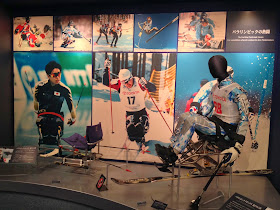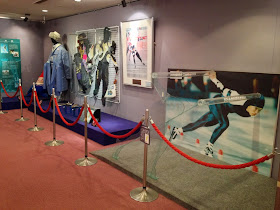M-Wave is the best place to visit to get a taste of the 1998 Winter Olympic Games. The venue was used for speed skating during the games and is currently used as a plublic ice skating rink in the winter and also as a training center for speed skating. The Olympic Stadium, used for the opening and closing ceremonies, White Ring, for figure skating and short track speed skating, and Big Hat, for hockey games, still stand and are used for sports and entertainment events and as sports facilities.
Why is M-Wave so important? Because the venues are scattered around the city, seeing them all is very time consuming. M-Wave is located a good ways from Nagano Station, but it houses the Nagano Olympic Museum.
It's possible to go into the arena and see the venue "up close" although you're confined to a somewhat small area. When I visited there were older children taking speed skating lessons on the outside track and some other events happening inside the ring, possibly short-distance speed skating for younger children. The back of the arena, from this perspective, has a rink which seemed to have some hockey practice.
The museum itself is beneath the stands. A replica press area is the first thing you see, and you can have your picture taken at the podium. The back-lighting on the signs can make that difficult.
After passing through the gift shop, which you'll return through on your way out, you get to the museum itself.
The displays are fairly complete showing a little bit from every aspect of the games. Here are some costumes from the opening ceremonies.
Medals and other memorabilia from both the Olympics and Paralympic Games are on display.
Uniforms from the competitions...
Merchandising...
Bling...
One part of the museum appears to be a touchy-feely area. By that, I think you're free to touch and pick up the different things used during the games.
As you see, there are uniforms, skis, and even a curling puck.
One wall had a display showcasing many of the games at the Nagano Olympics.
You can sit in a fake bobsled and watch a movie, similar to the Sapporo museum.
Bobsledding! Or whatever this is called, exactly. Since you're not in an enclosed sled.
Ski jump! The 1990s colors and pose makes me think of one word: Cowabunga!
There is some Paralympic Games equipment opposite the Olympic Games wall.
I don't know what these were used for, but I wouldn't mind having something like this to put on my wall.
The special exhibition room, which seems to double as a cafeteria, had a bunch of hockey memorabilia in cases.
I saw a bunch of other goods in the hallway display cases. It's hard to really pinpoint this other than a collection of Olympic goods.
Also in the wide hallway, you could take the pose of a figure skater. Note the clear outline profile.
The museum isn't exactly large, but given that it's devoted to a one-time event over just a few days, it's pretty comprehensive. There's also a theater which showed a short film on a loop. As I mentioned, there is a gift shop with Olympic memorabilia and winter sports magazines including several issues of a Japanese figure skating magazine.
I'm not sure how you would wear these, but I think they're mascot costumes. You can't try, since they put up plastic chains. And in Japan, chains are as good as a force field. In fact, putting up a small sign seems to be good enough.
The Olympic Museum is open only on weekends 10:00-17:00, though the souvenir shop is also open on weekdays. Admission is free but there is essentially no English information. You should be able to figure most of it out just by looking at it, though you miss out on the story, history, and names.
To get to the museum by bus from Nagano Station, go to Bus Stop 1 and take a bus toward Suzaka & Yashima, getting off at the M-Wave-Mae bus stop, which takes about 15 minutes. The return bus stop is across the street. There isn't really anything else around M-Wave, so plan on returning to Nagano afterwards.























Very cool. I've always been fascinated by what happens to Olympics sites after they've served their purpose. Usually I read about them being torn down or worse... abandoned. Glad to see this particular site is still in use.
ReplyDeleteJapan loves to tear down and rebuild. Apartment rent in any given city depends on three main things: size, distance from the nearest train station, and age. Older buildings are unpopular because they've been through earthquakes, and are built to prior, lower earthquake-proof standards. Japan also has an obsession with NEW. As soon as the iPhone 5 hit the shelves, iPhone 4 accessories almost completely disappeared.
ReplyDeleteBut as far as heritage goes, Japan is proud of what it has done right and the heritage and culture its known for. One of the biggest selling points about the 2020 Olympics here in Tokyo is that the infrastructure already exists.
Yes, that includes hotels, transportation, shopping, and other attractions as well, but several of the 2020 sites will be renovations, upgrades, or just reuse of existing venues from 50 years ago, and the plans for new structures include practical uses after the Games are over. That's easily done in a larger city, one that sees a lot of events and has several sports teams.
I've read about how expensive Sochi was and how the venues and infrastructure put together for the 2014 Olympics will probably fall into disrepair. Looking at Athens and similar cities, they had no plans after the Olympics. But some cities planned well in advance and their cities are doing well - Barcelona's waterfront, Atlanta's venues and housing, Salt Lake City. Their plans were practical and the designs were suited to future needs. Sochi has a plan of some sort, but are they realistic, or will the venues there suffer the same fate Beijing's Bird's Nest is having?
Turner Field was Atlanta's Olympic Stadium, but it was purposely built in such a way that it could be partially chopped up and turned into a proper stadium. Actually, I'm sad to see the Braves are moving out of town, because that's a great stadium... just under-served by public transportation. The new stadium will be worse in that respect, though - the location serves upper-middle class residents of the counties in that area, who all drive.
That's smart of those countries who plan ahead and think about the future before the construction begins. It seems like such a waste to build something, then just tear it down. I didn't realize the 2020 Olympics were going to be held in Japan. That should be an exciting period for all of you guys who live there (I'm so jealous).
DeleteI don't think any city or country makes a successful Olympic bid without at least planning to keep the structures, but I read yesterday that Athens had no plans with what to do with their venues after the games.
ReplyDeleteI'm wondering if I'll still be here in Japan in 2020. I'd like to say I will, but I really want to see more of the world, too.